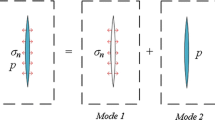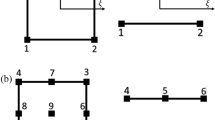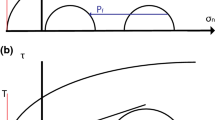Abstract
Rock is a heterogeneous geological material. When rock is subjected to internal hydraulic pressure and external mechanical loading, the fluid flow properties will be altered by closing, opening, or other interaction of pre-existing weaknesses or by induced new fractures. Meanwhile, the pore pressure can influence the fracture behavior on both a local and global scale. A finite element model that can consider the coupled effects of seepage, damage and stress field in heterogeneous rock is described. First, two series of numerical tests in relatively homogeneous and heterogeneous rocks were performed to investigate the influence of pore pressure magnitude and gradient on initiation and propagation of tensile fractures. Second, to examine the initiation of hydraulic fractures and their subsequent propagation, a series of numerical simulations of the behavior of two injection holes inside a saturated rock mass are carried out. The rock is subjected to different initial in situ stress ratios and to an internal injection (pore) pressure at the two injection holes. Numerically, simulated results indicate that tensile fracture is strongly influenced by both pore pressure magnitude and pore pressure gradient. In addition, the heterogeneity of rock, the initial in situ stress ratio (K), the distance between two injection holes, and the difference of the pore pressure in the two injection holes all play important roles in the initiation and propagation of hydraulic fractures. At relatively close spacing and when the two principal stresses are of similar magnitude, the proximity of adjacent injection holes can cause fracturing to occur in a direction perpendicular to the maximum principal stress.




















Similar content being viewed by others
References
Abou-Sayed AS, Brechtel CE, Clifton RJ (1978) In situ stress determination by hydrofracturing: a fracture mechanics approach. J Geophys Res 83(B6):2851–2862
Berchenko I, Detournay E (1997) Deviation of hydraulic fractures through poroelastic stress changes induced by fluid injection and pumping. Int J Rock Mech Min Sci 34(6):1009–1019
Biot MA (1941) General theory of three-dimensional consolidation. J Appl Phys 12(2):155–164
Bjerrum L, Nash JKTL, Dennard RM, Gibson RE (1972) Hydraulic fracturing in field permeability testing. Geotechnique 22(2):319–332
Bohloli B, de Pater CJ (2006) Experimental study on hydraulic fracturing of soft rocks: influence of fluid rheology and confining stress. J Petrol Sci Eng 53(1–2):1–12
Bolzon G, Fedele R, Maier G (2002) Parameter identification of a cohesive crack model by Kalman filter. Comput Methods Appl Mech Eng 191:2847–2871
Boone TJ, Wawrzynek PA, Ingraffea AR (1986) Simulation of the fracture process in rock with application to hydrofracturing. In J Rock Mech Min Sci 23(3):255–265
Boutt DF, Goodwin L, McPherson BJOL (2009) Role of permeability and storage in the initiation and propagation of natural hydraulic fractures. Water Resour Res, 45(Wooc13). doi:10.1029/2007WR006557
Bruno MS, Nakagawa FM (1991) Pore pressure influence on tensile fracture propagation in sedimentary rock. In J Rock Mech Min Sci 28(4):261–273
Cocchetti G, Maier G, Shen XP (2002) Piecewise linear models for interfaces and mixed mode cohesive cracks. Comput Model Eng Sci 3(3):279–298
Crosby DG, Rahman MM, Rahman MK, Rahman SS (2002) Single and multiple transverse fracture initiation from horizontal wells. J Petrol Sci Eng 35:191–204
Detournay E, Atkinson C (2000) Influence of pore pressure on the drilling response in low-permeability shear-dilatant rocks. In J Rock Mech Min Sci 37:1091–1101
Detournay E, Cheng H-DA (1998) Poroelastic response of a borehole in anon-hydrostatic stress field. Int J Rock mech Min Sci Geomech Abstr 25(3):171–182
Detournay E, McLennnan JD, Roegiers JC (1986) Poroelastic concepts explain some of the hydraulic fracturing mechanics. SPE Paper 15262 presented at the Unconventional Gas Technol. Symp. of the SPE, Louisville
Detournay E, Cheng A, Roegiers JC, McLennan JD (1989) Poroelasticity considerations in in situ stress determination by hydraulic fracturing. In J Rock Mech Min Sci 26:507–513
Geertsma J (1985) Some rock-mechanical aspects of oil and gas well completions. Soc Petrol Engrs J 25:848–856
Griffith AA (1920) The phenomena of rupture and flow in solids. Phil Trans R Soc A221:163–198
Guo F, Morgenstern NR, Scott JD (1993) Interpretation of hydraulic fracturing breakdown pressure. Int J Rock Mech Min Sci Geomech Abstr 30(6):617–626
Haimson BC, Fairhurst C (1969) Hydraulic fracturing in porous permeable materials. J Petrol Technol 2(1):811–817
Hossain MM, Rahman MK, Rahman SS (2000) Hydraulic fracture initiation and propagation: roles of wellbore trajectory, perforation and stress regimes. J Pet Sci Eng 27:129–149
Hubbert MK, Willis DG (1957) Mechanics of hydraulic fracturing. Trans AIME 210:153–163
Jaeger JC (1963) Extension failure in rocks subjected to fluid pressure. J Geophys Res 68:1759–1765
Jaeger JC, Cook NG (1979) Fundamentals of rock mechanics, 3rd edn. Chapman & Hall, London
Krajcinovic D (1996) Damage Mechanics. Elsevier, Amsterdam
Lo KY, Kaniaru K (1990) Hydraulic fracture in earth and rock fill dams. Can Geotech J 27(4):496–506
Medlin WL, Masse L (1979) Laboratory investigation of fracture initiation pressure and orientation. Soc Petrol Engrs J 19:129–144
Noghabai K (1999) Discrete versus smeared versus element-embedded crack models on ring problem. J Eng mech 125(3):307–315
Rubin MR (1983) Experimental study of hydraulic fracturing in an impermeable material. J Energy Resour Technol 105:116–124
Rummel F (1987) Fracture mechanics approach to hydraulic fracturing stress measurements. In: Atkinson B (ed) Fracture mechanics of rock, Academic Press, New York, p 317–239
Saouma V, Natekar D, Sbaizero O (2002) Nonlinear finite element analysis and size effect study of a metal-reinforced ceramics-composite. Mater Sci Eng A323:129–137
Tang CA (1997) Numerical simulation on progressive failure leading to collapse and associated seismicity. Int J Rock Mech Min Sci 34:249–262
Tang CA, Yang WT, Fu YF, Xu XH (1998) New approach to numerical method of modelling geological processes and rock engineering problems—continuum to discontinuum and linearity to nonlinearity. Eng Geol 49(3–4):207–214
Tang CA, Tham LG, Lee PKK, Yang TH, Li LC (2002) Coupled analysis of flow, stress and damage (FSD) in rock failure. Int J Rock Mech Min Sci 39(4):477–489
Thallak S, Rothenbury L, Dusseault M (1991) Simulation of multiple hydraulic fractures in a discrete element system. In: Roegiers JC (ed) Rock mechanics as a multidisciplinary science, Proceedings of the 32nd US Symposium. Balkema, Rotterdam, pp 271–280
Wang MS, Nakagawa FM (1991) Pore pressure influence on tensile fracture propagation in sedimentary rock. Int J Rock Mech Min Sci 28(4):261–273
Wang SY, Sun L, Au ASK, Yang TH, Tang CA (2009) 2D-numerical analysis of hydraulic fracturing in heterogeneous geo-materials. Constr Build Mater 23:2196–2206
Wang SY, Sloan SW, Liu HY, Tang CA (2011) Numerical simulation of the rock fragmentation process induced by two drill bits subjected to static and dynamic (impact) loading. Rock Mech Rock Eng 44:317–336
Warpinski NR, Teufel LW (1987) Influence of geologic discontinuities on hydraulic fracture propagation. J Petrol Technol 39(2):209–220
Weibull W (1951) A statistical distribution function of wide applicability. J Appl Mech 18:293–297
Yanagisawa E, Panah AK (1994) Two dimensional study of hydraulic fracturing criteria in cohesive soil. Soils Found 34(1):1–9
Yang TH, Tang CA, Zhu WC, Feng QY (2001) Coupling analysis of seepage and stress in rock failure process. Chinese J Rock Soil Eng 23(4):489–493
Zhu WC, Tang CA (2004) Micromechanical model for simulating the fracture process of rock. Rock Mech Rock Eng 37:25–56
Acknowledgments
The work described in this paper was partially supported by ARC Australian Laureate Fellowship Grant FL0992039 and ARC CoE Early Career Award Grant CE110001009, for which the authors are very grateful.
Author information
Authors and Affiliations
Corresponding author
Rights and permissions
About this article
Cite this article
Wang, S.Y., Sloan, S.W., Fityus, S.G. et al. Numerical Modeling of Pore Pressure Influence on Fracture Evolution in Brittle Heterogeneous Rocks. Rock Mech Rock Eng 46, 1165–1182 (2013). https://doi.org/10.1007/s00603-012-0330-2
Received:
Accepted:
Published:
Issue Date:
DOI: https://doi.org/10.1007/s00603-012-0330-2




